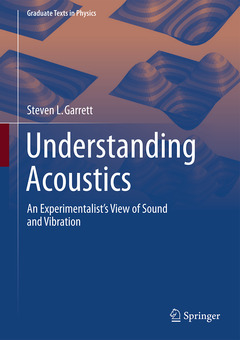Understanding Acoustics (2nd Ed., 2nd ed. 2020) An Experimentalist’s View of Sound and Vibration Graduate Texts in Physics Series
Auteur : Garrett Steven L.

- Provides graduate-level treatment of acoustics and vibration suitable for use in courses, for self-study, and as a reference
- Highlights fundamental physical principles that can provide independent tests of the validity of numerical solutions, commercial software, and computer simulations
- Demonstrates approximation techniques that greatly simplify the mathematics without a substantial decrease in accuracy
- Incorporates a hydrodynamic approach to the acoustics of sound in fluids that provides a uniform methodology for analysis of lumped-element systems and wave propagation
- Emphasizes actual applications as examples of topics explained in the text
- Includes realistic end-of-chapter problems, some including experimental data, as well as a Solutions Manual for instructors.
- Features ?Talk Like an Acoustician? boxes to highlight key terms introduced in the text.
Provides graduate-level treatment of acoustics and vibration suitable for use in courses, for self-study, and as a reference
Highlights fundamental physical principles that can provide independent tests of the validity of numerical solutions, commercial software, and computer simulations
Demonstrates approximation techniques that greatly simplify the mathematics without a substantial decrease in accuracy
Incorporates a hydrodynamic approach to the acoustics of sound in fluids that provides a uniform methodology for analysis of lumped-element systems and wave propagation
Emphasizes actual applications as examples of topics explained in the text
Includes realistic end-of-chapter problems, some including experimental data, as well as a Solutions Manual for instructors
Features “Talk Like an Acoustician“ boxes to highlight key terms introduced in the text
Request lecturer material: sn.pub/lecturer-material
Date de parution : 11-2020
Ouvrage de 783 p.
17.8x25.4 cm
Thèmes d’Understanding Acoustics :
Mots-clés :
Waves in fluids; Acoustics textbook; Elastic waves; Physical acoustics; Engineering acoustics; Electroacoustic transduction; Acoustic radiation; Harmonic oscillators; Acoustic wave propagation; Approximation techniques; Similitude in acoustics and vibration; Modes of enclosures; Waveguides; Nonlinear acoustics; Acoustic levitation; Open Access



